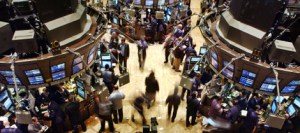
Perfect Five-ETFs


I’m selling VEA out of my Perfect 5 ETF Portfolio today
I'm continuing to revise the holdings in my Perfect 5 ETF Portfolio in order to reduce risk from the effects of a global trade war and yet to still make some money--as I outlined in my Special Report: 5 Places to Hide from a Downturn--and Still Make Some Money. I...
I’m buying the Utilities Select Sector SPDR ETF in my Perfect 5 Portfolio today
To subscribe to JAM you need to fill in some details below including, ahem, some info on how you'll pay us. A subscription is $199 (although if you're subscribing with one of our special offers it will be lower) for a year for ongoing and continuing access to the...
I’m selling the Invesco KBW Bank Portfolio ETF out of my Perfect 5 ETF Portfolio
As I outlined in my recent special report "Five Places to Hide from a Downturn--and Still Make Some Money" on my JubakAssetManagemnt.com site, I think worry over the added downside potential for stocks created by everything from the tariff war, to higher interest...
Best performing ETF in my Perfect 5 ETF Portfolio? PowerShares KBW Bank Portfolio
Of the five ETFs in my Perfect 5 ETF Portfolio only one has outperformed the S&P 500. Since I added it to the portfolio on October 5, 2017 the PowerShares KBW Bank Portfolio ETF (KBWB) has gained 11.01% through 3:30 p.m. on May 22. That beats the second-best 8.45%...
Rebalancing my Perfect 5 ETF portfolio to hedge against a break through the February 8 low
When I last rebalanced my Perfect 5 Active Passive ETF Portfolio on January 16, I said that I’d rebalance it again on July 1–unless events intervened to force an unscheduled rebalancing. Well, events have indeed intervened. The S&P 500 index closed within a handful of points of the February 8 low today, March 23. If the index and the U.S. stock markets were only going to drop another few points and then hold (or even bounce on that low), I wouldn’t feel the need to rebalance. But there’s a good chance the market will fail its test of the February 8 low.

Gold keeps climbing on rising demand from ETFs
Gold held by ETFs that invest in the yellow metal rose to 2,250 metric tons on January 22, according to Bloomberg. That’s the highest level of gold held by ETFs since May 2013. After turning in its best year since 2010 in 2017, gold has continued to climb in 2018

Finally. As promised. Perfect 5 ETF Portfolio performance and rebalancing–up 8.6% since October
Back in October 2017 I set up a very simple portfolio of 5 ETFs with the goal of beating the performance of a Standard & Poor’s 500 ETF (so that’s the benchmark) with less risk (because of the added diversification.) I said that I would rebalance this portfolio as needed–or on a six month schedule (which ever came first.) But that this would be a relatively passive portfolio of passive ETFs–but with some active management thrown in by way of those shifting allocations. Well, the portfolio certainly isn’t six months old, but we have flipped the calendar page into 2018 so I’m going to do the first performance report now and at the same time do an initial rebalancing of assets.

The coming of no fee ETFs
Deutsche Bank just took the ETF industry another step closer to zero fee ETFs. On October 30 the bank cut the net expense ratio charged by its flagship high-yield ETF, the Xtrackers USD High Yield Corporate Bond ETF (HYLB) to 0.2% from 0.25%. The move follows on a decision by ETF giant State Street to lower the expense ratios of 15 of its most popular ETFs. Deutsche Bank’s move to slash fees follows the decision by investment manager State Street Global Advisors to lower expense ratios on 15 of its popular ETFs.

My last post setting up my new Perfect 5 ETF Portfolio: How to use it along with my Volatility Portfolio
I’ve named the five ETFs in this portfolio. Explained my ideas on allocation money among those five ETFs and their associated asset classes. And discussed the importance of knowing what index an ETF follows. Now it’s time to explain one last thing to complete the set up of this new portfolio: Why I’ve positioned it next to my Volatility Portfolio on JugglingWithKnives.com and JubakAM.com.

Making a tweak–yes, already–to the Perfect 5 ETF Portfolio to get more Japan in the mix
I certainly don’t intend to turn the Perfect 5 ETF Active Passive Portfolio into a trading portfolio, but when facts on the ground change, I do want to respond. The recent overwhelming election victory of Japanese Prime Minister Shinzo Abe has given Abe-nomics renewed life. That means financial markets and Japan’s huge export sector can count on continued policies from the Bank of Japan that weaken the yen versus the currencies of trading partners and that look to increase growth in the Japanese economy from the country’s export sector. Japan’s stock market has been on something of a tear in 2017 and I think that’s likely to continue

European Central Bank decides to split the difference on ending bond purchases
At its meeting today the European Central Bank decided to buy fewer bonds each month but for more months. Monthly purchases will be cut to 30 billion euros ($35 billion) from 60 billion euros beginning in January. But the bank will extend its bond purchases until September. Some observers had through the central bank would end purchases in January or March.



